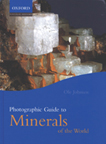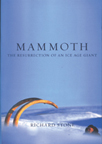
Photographic Guide to Minerals of the World
by Ole Johnsen, Oxford University Press (2002), ISBN 0-19-851568-5. £17.99

Book Review will return next month.
Scientists and Reporters:
Tips for scientists who talk with the media
Maps
On the Shelf
Geoscientists are comfortable in some scary situations: scrambling up mountains,
handling hazardous chemicals, confronting classrooms filled with students, working
in the face of landslides and volcanoes. But the prospect of talking with journalists
leaves many of us shaking in our shoes.
We may be afraid of being misquoted by the media, misunderstood by the public,
and misrepresented to our colleagues. But we’re increasingly expected to
communicate our results to the public, and often the media will act as an intermediary.
Fortunately, media coverage has many potential rewards. And it may take only
a little extra effort to help a journalist describe your work both accurately
and evocatively.
“Publish in a scientific journal, and a few people will see it. Publish
in a newspaper or magazine, and you’ll have readers everywhere,” points
out Ann Cairns, Director of Communications for the Geological Society of America.
Most scientists know that the popular press is a potential route to communicate
with the public and potentially with policymakers. But publishing in popular
forums is also an opportunity to reach fellow scientists, especially those working
in other disciplines. Working with journalists is “a way to get your work
in front of people who aren’t reading the journals in your specialized
discipline,” Cairns says.
Of course, press coverage also promotes public understanding of the geosciences.
It encourages scientifically sound policymaking. And seeing your work described
in a local newspaper or your favorite magazine also offers the more personal
reward of affirmation. “When the story gets published, scientists recognize
that their work is of interest to people. It’s just great,” Cairns
adds.
Geoscientists commonly meet members of the press when they present their work
at meetings, after publishing books or papers, and when popular news stories
require scientific explanation. In all of these situations, following a few
words of advice can help you — and your profession — to reap the rewards
of media coverage.
Just as with teaching, the first step is to know your audience. Journalists
have a wide variety of backgrounds, goals and deadline pressures.
Ask how soon a journalist will need a response from you. A reporter from a daily
newspaper, for example, might need to hear from you the day a story breaks.
Ask how much background information you should provide. Some journalists specializing
in science will know the basics; others may need a lot of help understanding
your work. If possible, provide background information, including relevant publications,
before an interview.
Regardless of the journalist’s background, you will need to explain things
differently than when you’re talking with fellow scientists.
“Think as if you were at a dinner party, and someone asked about your work,”
says Tom Yulsman, professor of journalism at the University of Colorado and
former editor of Earth magazine. “Journalists are jacks-of-all-trades,
masters of none. It’s difficult to know all the background, especially
under a deadline. Some scientists don’t understand this dilemma, because
their work is usually so focused.”
If you’re worried about being misunderstood, the best insurance is to present
a clear, straightforward story. “If you’re afraid something will be
lost in translation, make the translation yourself and you’ll have less
to worry about,” Cairns says.
“Be really clear. Try to anticipate how something could be misunderstood.
Think about what you’re going to say ahead of time,” Yulsman suggests.
Try to incorporate helpful analogies and vivid imagery. Be clear and concise.
Use short, quotable sentences.
And remember that journalists are looking, above all else, for a good story.
“What is newsworthy? Why is this important? They need that information,”
Yulsman says. You can help by pointing out what is most important or novel about
your work.
Knowing some journalistic etiquette will also help: Respond quickly to inquiries,
or your opinion may go unheard. Provide the names of your colleagues and funding
sources. Emphasize the uncertainties in your results, and suggest other sources
of information. Recognize that a good journalist will talk to other sources,
and what you say may be only a small part of the reporter’s story. Although
it’s helpful to be available for follow-up questions, don’t expect
to read the story before it gets published; trust the writer to do a professional
job.
Your employer might have a public relations department that can provide further
advice about working with the media. Other resources include training workshops
and discussions at professional meetings, and books such as Geomedia: A Guide
for Geoscientists who Meet the Press, written by Lisa Rossbacher and Rex Buchanan
and published by the American Geological Institute.
If, after trying hard to get your ideas across, you’re still unhappy with
how a journalist covers your work, consider the implications. Was the story
detrimental to the public, to your profession or just to your ego? Give it another
try.
“Please don’t let one bad experience with a journalist turn you off,”
Yulsman says. “Scientists don’t reach conclusions from a single observation.
Think in the longer term. You’ll help journalists do a better job if you
work at it.”
I-2543. ALASKA. Geologic and isostatic map of the Nenana basin area, central Alaska by G.M. Frost, D.F. Barnes and R.G. Stanley. 2002. Scale 1:250,000. One color sheet accompanied by 16 pages of text. $7.
I-2764. UTAH and COLORADO. Stratigraphy of the Upper Cretaceous Mancos Shale (upper part) and Mesaverde Group in the southern part of the Uinta and Piceance Basins, Utah and Colorado by R.D. Hettinger and M.A. Kirschbaum. 2002. Two color sheets accompanied by 21 pages of text. $14.
MF-2341. COLORADO. Geologic map of the Rifle Falls quadrangle, Garfield County, Colorado by R.B. Scott, R.R. Shroba and A.E. Egger. 2002. Scale 1:24,000. One color sheet accompanied by 19 pages of text. Available free at: greenwood.cr.usgs.gov/pub/mf-maps/mf-2341/, or for $20 as print-on-demand.
MF-2394. ARIZONA. Geologic map of Clayhole Wash and vicinity, Mohave County, northwestern Arizona by G.H. Billingsley, S.S. Priest and S.L. Dudash. 2002. Scale 1:31,680. One color sheet accompanied by 21 pages of text. Available free at: geopubs.wr.usgs.gov/map-mf/mf2394.
To order USGS maps, contact USGS Information Services, P.O. Box 25286, Denver, CO, 80225. Phone: 888/ASK-USGS (888/275-8747). Maps identified as print-on-demand may be downloaded from the Internet, or USGS can run a copy for a charge as noted.
 |
Photographic Guide to Minerals of the World by Ole Johnsen, Oxford University Press (2002), ISBN 0-19-851568-5. £17.99 |
Spectacular images fill this hardcover guide targeted at students and amateur
geologists. Approximately 500 minerals are included. Although the guide includes
a primer on crystallography, the emphasis throughout is on hand-sample identification
rather than more sophisticated optical or x-ray methods.
 |
Distant Wanderers by Bruce Dorminey, Copernicus Books (2002), ISBN 0-387-95074-5. Hardcover, $29.95. |
Subtitled “The Search for Planets Beyond the Solar System,” this
book focuses on the current race among astronomers to identify planets orbiting
stars other than the Sun. The narrative, written by a science journalist, is
based on an extensive series of interviews with leading astronomers. It conveys
the excitement of rapid scientific discovery as technology opens up new opportunities.
The book also delves into the impact of these “distant wanderers”
on theories of planet formation and possible fingerprints of another living
planet.
 |
Mammoth: The Resurrection of an Ice Giant by Richard Stone, Perseus Publishing (2002), ISBN 0-7382-0775-6. Paperback, $15. |
Award-winning science journalist Richard Stone (Geotimes, June 2001)
explores what it will take for a mammoth to walk across Siberia’s frozen
tundra again, and the efforts of the scientists involved in making such an event
happen. He puts in perspective the ancient history and interaction humans had
with mammoths and the different explanations for why mammoths went extinct.
“The mammoth survived much longer than many people realize,” Stone
says. “The last of their kind died out on an Arctic island only 3,700 years
ago, long after the Great Pyramids at Giza were built.”
Back to top
 |
Geotimes Home | AGI Home | Information Services | Geoscience Education | Public Policy | Programs | Publications | Careers |